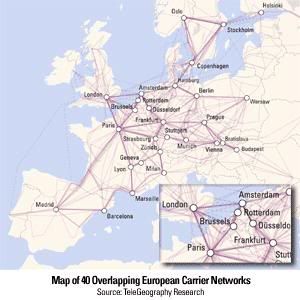Previous Posts
Archives
Links
telco newsletter
Samstag, Juni 11, 2005
200506-3: Most Intercity Bandwidth Still Unlit
Despite significant and consistent growth in data traffic flows across the world's communications networks, a huge portion of potential network capacity remains unused. Based on research released this month in TeleGeography's International Bandwidth report and database, only three percent of the maximum possible intercity bandwidth in Europe and the U.S. has been "lit" for service provision.
For example, the 32 terrestrial carriers connecting to the New York metropolitan area have a combined potential capacity of 818.2 Terabits per second. Of that, only 22.6 Terabits per second -- 2.8 percent -- of network bandwidth is actually lit.
However, the aggregated fiber glut does not translate to a bandwidth glut for all carriers on all routes. In fact, many carriers are actually running out of bandwidth on certain network segments, and are having to face unwelcome network upgrade costs. For certain, they won't need to lay new fiber. But lighting dark fiber or adding wavelengths on existing fiber can be extremely expensive, and carriers may have a hard time taking on major new costs in what is still a very competitive market subject to rapid price erosion.

For example, the 32 terrestrial carriers connecting to the New York metropolitan area have a combined potential capacity of 818.2 Terabits per second. Of that, only 22.6 Terabits per second -- 2.8 percent -- of network bandwidth is actually lit.
However, the aggregated fiber glut does not translate to a bandwidth glut for all carriers on all routes. In fact, many carriers are actually running out of bandwidth on certain network segments, and are having to face unwelcome network upgrade costs. For certain, they won't need to lay new fiber. But lighting dark fiber or adding wavelengths on existing fiber can be extremely expensive, and carriers may have a hard time taking on major new costs in what is still a very competitive market subject to rapid price erosion.
